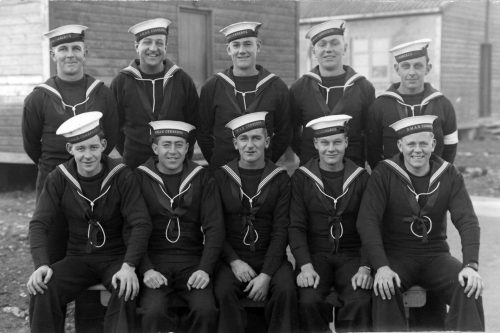- Author
- Wright, Ken
- Subjects
- Ship histories and stories, WWII operations, History - WW2
- Tags
-
- RAN Ships
- None noted.
- Publication
- December 2008 edition of the Naval Historical Review (all rights reserved)
Lt. Keith Hudspeth was awarded the DSC no less than three times. The first was for participation in a midget submarine attack on the German battle ship Tirpitz hiding in a Norwegian fjord. The two additional DSCs were for actions off the Normandy coast in preparation for the D‑Day invasion of 6 June 1944.

Of the five hundred volunteers, thirty six paid the ultimate price during their active service with the Royal Navy or other duties during WW2. The following are a few brief examples of how some of the men lost their lives together with their British shipmates.
HMS Hood
At approximately 0549 on 24 May 1941, the pride of the British fleet, HMS Hood, fired the opening salvo in the Battle of the Denmark Strait between the Hood and HMS Prince of Wales on one side and the Bismarck and Prinz Eugen on the other. Although the Hood scored hits on the Bismarck with the second salvo, it was all over within 11 minutes. The Bismarck with her fifth salvo hit Hood, starting a fire which in turn set off Hood’s ready-use ammunition; this resulted in a massive explosion and she was gone in three minutes. It should be pointed out that in light of modern research, there is debate as to whether one 15” shell from the Bismarck or one or more 8” high explosive shells from Prinz Eugen actually caused the dramatic loss of such a famous ship. Whatever the true facts may be, the loss had a great effect on British morale. Of the 1,418 crew, only three men survived and were later rescued by the destroyer HMS Electra. Four RANVR members, G.W. Hall, I.G.E. Startup, J.D. Shannon and D.G. Hall, were among those who perished.
Operation Jubilee
In the early hours of 19 August 1942, a fleet of two hundred and thirty nine ships arrived off the French coast at Dieppe. Operation Jubilee was in response to the fact that the Western allies were at this point in time unable to open a second front in Europe. It was decided to mount a large scale raid on the French coast and take some pressure off the efforts of the Russian allies in the east. The ships carried a cargo of more than 5,000 men – tough British and Canadian troops who were determined to destroy the German coastal gun emplacements at Dieppe. The daring raid became one of the biggest military blunders in history from which only a third of the men returned. Acting Lieutenant- Commander H.P. Brownell RANVR was among those killed.
Loss from U-Boats
The SS Ceramic, a White Star [later Shaw Savill] liner of 18,481 gross tons set sail as a troop transport from Liverpool bound for Australia on 23 November, 1942. When 1,148 kilometres west-northwest of the Azores, the ship was torpedoed three times on December 6 and sunk by U-boat 515 commanded by Korvettenkapitan Werner Henke. A total of 655 crew, troops and nurses lost their lives. Only Sapper Eric Munday, Royal Engineers survived and was rescued by the U-boat crew. Two of those who perished, A.R. Cutts and B.D. O’Donoghue, were of the RANVR.
HMS Bluebell
Just eight miles north-east from the Kola Islet, a Flower class corvette HMS Bluebell was on duty as close escort for convoy RA64 en route to England from Russia, when she was hit by a torpedo from U-711 on 17 February 1945. The torpedo hit Bluebell’s stern and detonated the depth charges stored there. A massive explosion tore the stern off, the ship sinking in just 30 seconds. Only 12 crew were saved. Lieutenant W.W. Twiss RANVR went to the ocean floor along with the remainder of the British crew.
Up until July 1944 seventy two members of the RANVR had received various accolades, awards and decorations including two George Crosses, seven George Medals and three bars, three Distinguished Service Crosses and three bars, and one Conspicuous Gallantry Medal as well as the Greek Cross and a Presidential Citation.




